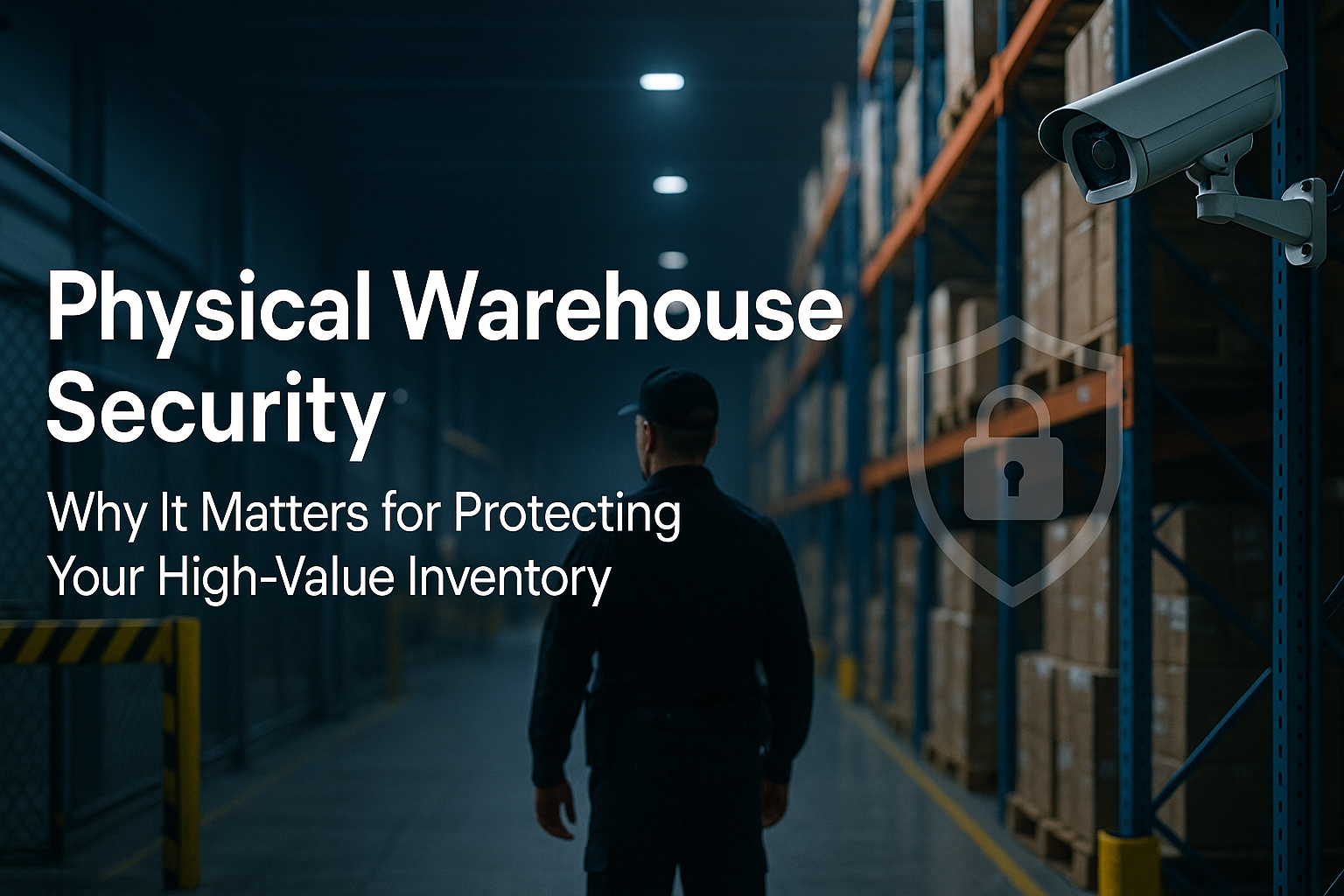Physical Warehouse Security: Why It Matters for Protecting Your High-Value Inventory
In the high-stakes world of e-commerce and logistics, a warehouse is more than just a building—it’s the heart of your operation. It’s where your most valuable assets live, waiting to be sent to customers around the globe. But what happens when that heart is vulnerable? The truth is, without a robust physical warehouse security strategy, your business is exposed to a range of costly threats, from theft and vandalism to product damage and operational disruption. In this comprehensive guide, we’ll explore why top-tier physical security is non-negotiable for businesses handling high-value inventory and how you can build a fortress around your products.
The Real Cost of Inadequate Warehouse Security
Many businesses view security as a cost center, but the reality is that it’s a critical investment with a direct impact on your bottom line. The financial and reputational fallout from a security breach can be devastating. Here’s what’s at stake:
- Direct Financial Loss: This is the most obvious consequence. Stolen goods, whether through internal or external theft, directly cut into your revenue. For businesses dealing with high-value items like electronics, luxury goods, or pharmaceuticals, a single incident can result in millions of dollars in losses.
- Operational Disruption: A security breach isn’t just about what’s lost; it’s about the domino effect. An incident can halt your fulfillment processes, delay shipments, and require a time-consuming investigation. This disruption can lead to unhappy customers and a backlog that takes days or even weeks to resolve.
- Reputational Damage: News of a security breach can quickly spread, eroding customer trust. When customers learn their orders or personal data might be at risk, they may turn to competitors. A damaged reputation is hard to repair and can have long-term consequences for brand loyalty and growth.
- Insurance and Legal Consequences: Inadequate security can lead to higher insurance premiums or, in the worst-case scenario, denied claims. Furthermore, depending on the nature of your inventory (e.g., regulated goods), a breach could lead to legal and regulatory penalties.
These factors show that physical security is not an afterthought; it’s a foundational pillar of a successful logistics strategy. For more on how strategic warehousing can optimize your business, check out our guide on Warehouse & Storage solutions.
Components of a Robust Physical Warehouse Security System
A truly effective security plan is a multi-layered defense. It combines technology, well-defined processes, and trained personnel to create a secure environment. Let’s break down the key components.
1. Perimeter Security and Access Control
The first line of defense is the physical barrier around your facility. This includes:
- High-Security Fencing: A tall, sturdy fence with controlled entry points discourages unauthorized access.
- Monitored Gate and Access Points: All vehicle and pedestrian entry points should be monitored 24/7. Access control systems, such as keycards or biometric scanners, ensure that only authorized personnel can enter restricted areas.
- Adequate Lighting: Well-lit perimeters and parking lots act as a powerful deterrent.
2. Surveillance and Monitoring
This is where technology plays a crucial role. A comprehensive surveillance system provides constant oversight and a valuable record in case of an incident.
- CCTV Cameras: High-resolution cameras should be strategically placed to cover all entry points, loading docks, storage areas, and high-value zones. Modern systems offer features like motion detection and remote monitoring.
- Alarm Systems: Alarms that trigger when a breach is detected can alert security personnel and law enforcement immediately.
- Real-Time Monitoring: A dedicated security team or a third-party service should be monitoring feeds and alarms around the clock.
3. Internal Security Measures
Security isn’t just about keeping people out; it’s also about managing what happens inside. A significant portion of theft is internal, making these measures essential.
- Segregated Storage Areas: High-value inventory should be stored in a separate, caged area with its own access control and monitoring. This creates an extra layer of protection.
- Employee Vetting: Conducting thorough background checks on all employees who handle inventory is a fundamental part of risk management.
- Inventory Audits: Regular, unannounced inventory counts help you quickly identify discrepancies and deter internal theft. This is a core part of effective Warehouse & Storage management.
For a detailed look at the internal processes that safeguard your inventory, see our comparison of traditional vs. modern security approaches below.
Case Study: The Proactive Approach to Security
Consider a hypothetical e-commerce company, “TechLux,” specializing in high-end electronics. They initially operated with a basic security setup: a fence, a few cameras, and a padlock on the main door. After a series of minor thefts, they realized their approach was reactive and unsustainable.
They partnered with a 3PL provider like WarehouseTX, which implemented a multi-faceted security plan:
- Access Control: TechLux employees were given keycards with tiered access. Warehouse staff could only enter general storage areas, while a small, vetted team had access to the high-value electronics cage.
- Advanced Monitoring: High-definition CCTV with AI-powered analytics was installed. The system could alert security personnel to unusual activity, such as someone loitering near the high-value area or a package being left in an unauthorized zone.
- Regular Audits: The 3PL conducted daily spot checks and weekly full audits of the electronics inventory. Any discrepancies were flagged and investigated immediately.
Within a quarter, TechLux saw a 95% reduction in inventory shrinkage and a significant increase in operational efficiency. This case demonstrates that a proactive, layered security strategy isn’t just about preventing loss—it’s about building a more reliable and trusted supply chain.
—
Comparative Analysis: Traditional vs. Modern Warehouse Security
The logistics industry has evolved, and so have security threats and solutions. Here’s a comparative look at the traditional “lock and key” approach versus a modern, tech-driven strategy.
| Feature | Traditional Security | Modern Security (e.g., WarehouseTX) |
|---|---|---|
| Approach | Reactive (responding to incidents) | Proactive (preventing incidents) |
| Access Control | Physical keys, sign-in sheets | Biometric scanners, keycard systems, digital logs |
| Surveillance | Limited, low-resolution cameras | High-definition CCTV with AI, remote monitoring |
| Inventory Tracking | Manual counts, paper logs | Real-time inventory management systems (WMS) with barcode/RFID scanning |
| Internal Theft Prevention | Trust-based system, occasional checks | Mandatory background checks, segregated storage, continuous audits |
| Cost-Effectiveness | Lower initial cost, higher risk of loss and long-term expenses | Higher initial investment, significant long-term savings through loss prevention |
—
Expert Insights: Making the Right Security Decisions
When evaluating a warehouse partner, ask the right questions about their security protocols. Don’t just settle for “we have cameras.” Look for a partner that prioritizes these key areas:
Operational Security Best Practices:
- Do they have a dedicated security team?
- Are security protocols regularly reviewed and updated?
- Do they conduct mandatory employee background checks and training?
- Is there a clear chain of command for reporting security incidents?
Technological Security Measures:
- What type of surveillance technology do they use?
- Is there an advanced access control system in place?
- How do they handle data security for inventory and customer information?
Choosing a 3PL with a proven commitment to security is not just about protecting your inventory; it’s about safeguarding your brand’s reputation and ensuring the smooth, efficient operation of your supply chain. When you partner with a service provider like WarehouseTX, you’re not just getting a space—you’re getting a secure, technology-driven ecosystem designed for growth.
For more details on how we protect your assets, feel free to contact us and discuss your specific security needs.
—
Frequently Asked Questions About Warehouse Security
What is the most common cause of warehouse theft?
The most common causes of warehouse theft are a combination of internal and external factors. While external break-ins are a risk, a significant portion of inventory shrinkage comes from internal theft by employees or contractors. This is why a comprehensive security strategy must include both physical barriers and internal controls, such as employee background checks, strict access control, and regular inventory audits.
How can a Warehouse Management System (WMS) improve security?
A WMS is a powerful tool for enhancing security. It provides real-time visibility into inventory levels and movements, allowing you to track every item from the moment it enters the warehouse to when it’s shipped. This digital trail helps in identifying discrepancies quickly, preventing “lost” products, and creating an accountability system that deters theft. It essentially acts as a digital audit trail for your physical inventory.
Is it better to have in-house security or to outsource it to a 3PL?
The choice depends on the size and scope of your business. However, outsourcing security to a reputable 3PL (Third-Party Logistics) provider often offers significant advantages. 3PLs specialize in logistics and have already invested in advanced security technology, trained personnel, and proven protocols. This allows you to leverage their expertise and infrastructure without the high cost and complexity of building your own system from scratch. A good 3PL can offer a level of security that is difficult and expensive to replicate internally.
How do climate-controlled warehouses factor into security?
Climate-controlled warehouses are primarily designed to protect high-value or sensitive inventory from environmental damage (e.g., extreme temperatures, humidity). While this is a form of product protection, it also contributes to overall security by maintaining the integrity and value of your goods. A secure, climate-controlled environment ensures that your products are protected not only from theft but also from damage that could render them unsellable, thereby preserving their value and your investment.
What is a good starting point for improving my warehouse’s physical security?
A great first step is to conduct a comprehensive security audit. Identify your most vulnerable points, from entryways and loading docks to high-value storage areas. Assess your current technology and processes to see where you have gaps. From there, you can prioritize improvements, starting with basic measures like better lighting and access control, and gradually incorporating more advanced technologies like a WMS and CCTV surveillance. Partnering with a logistics expert can provide a valuable, objective perspective on your security needs.

